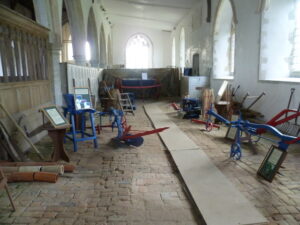This Lent we’re looking at some of the churches on Romney Marsh. This week it’s part two of a history of St George at Ivychurch, which is known as the Cathedral of the Marsh because of its size. In part one we told the story of how the church came to be built, for the second article we head inside.
Much work was carried out during the 18th century. A triple decker pulpit was added with desk for the clerk, lectern and pulpit – now reduced to just the pulpit. Religious text plaques called decalogues were added, along with box pews introduced in 1728 – sadly since removed. There are Chinese Chippendale style gates closing the side chapels, probably taken from Old Romney church. The arms of King George III are on the north wall, as required by statute post-Reformation until the reign of Queen Victoria, a reminder that the sovereign not the Pope was head of the English church. A rare survival again is a hudd or hood, a wooden cover for the use of the priest during wet weather funerals.
There are oak screens either side of the choir, originally part of the old rood screen, dividing the nave from the chancel with a gate. Its exact date of removal is uncertain, but there is an unsubstantiated story about it. At one time the curate was Mr Boys, a Royal Naval chaplain in the time of Nelson. He was, shall we say, a very regular visitor to the Bell Inn by the church and at other local hostelries where he would tell stories of his navy days. Once, having taken on a surfeit of rum, he is said to have chopped the screen into pieces.
Another legend has it that there are tunnels between St George’s and the Bell Inn, used by smugglers for moving their nefarious goods around. It has been claimed that for a time in the 18th century the church was so full of smuggled goods that it was impossible to hold services there. The sexton is once supposed to have told the rector, ‘Baint no service this morning, parson, pulpit be full o’baccy and the vestry be full o’brandy.’

During 1888-90 the Rye based architect Sir Reginald Blomfield undertook a sympathetic restoration of St George’s. Too many churches were restored at the same time by other, perhaps less thoughtful architects, resulting in out of place additions and injudicious removals taking away the aura that that built up over the years – so much so that they may as well have totally rebuilt the place. Blomfield admired St George’s greatly, stating that it was one of the best examples of 14th century work and the best church in the area. As grandson of a Bishop of London, I think we should allow him some especial knowledge of that subject.
More work was necessary in the early 20th century. The roof is recorded as having 20 holes in it, and rats and mice were making themselves at home – presumably church mice? The box pews had rotted away and so were removed leaving an impressive open space in their stead. The damage was made good but more damage occurred on October 13 1940 when a stick of six German high explosive bombs hit Ivychurch and smashed the church windows. The rectory was bombed on June 15 1944, and one of the terrible flying bombs, the V1 rockets, hit the village damaging the church again and six houses. The church had to close until its roof and windows were repaired in 1948. Further work has been carried out since.
There was another problem in 2008 when vicious hail stones damaged 50 panes of glass in the windows at the west end. Inspection found the big window in the tower had to be completely rebuilt, the only medieval window in the diocese ever to need this amount of work.

Now in good order and open most days, the north aisle houses a museum of English rural life showcasing 20th century farming in the form of the collection of a local farmer.
As in so many villages, life seems to revolve around two centres, the church and local pub. The Bell is well-known for its musical entertainment and annual beer and cider festival. The name of the village is of Saxon derivation, originally meaning island with a burial ground. Circ means a round burial ground from Celtic times, built above the surrounding area to ensure that the dead remained dry. The circle was connected to the idea of immortality. Over the years the name has changed, as so often happens.
There’s another Romney Marsh church in next week’s Rye News when we’ll be visiting St Dunstan’s in Snargate.
Image Credits: Geograph/Michael Garlick https://commons.wikimedia.org/wiki/File:Ivychurch,_St._George%27s_Church,_The_late_c14th_octagonal_font_from_the_south_aisle_-_geograph.org.uk_-_4761992.jpg cc https://creativecommons.org/licenses/by-sa/2.0/, Geograph https://commons.wikimedia.org/wiki/File:Ivychurch,_St._George%27s_Church_-_geograph.org.uk_-_4646332.jpg CC https://creativecommons.org/licenses/by-sa/2.0/, Marathon https://www.geograph.org.uk/photo/3983984 cc https://creativecommons.org/licenses/by-sa/2.0/.



